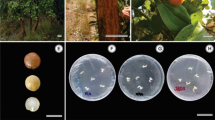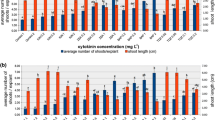Abstract
Medicinal properties of Butea monosperma (BM) and overexploitation of bark as a rich source of flavonoids for different biological activities, development of efficient method for high frequency somatic embryos and in vitro synthesis of bioactive secondary metabolites using plant tissue culture technology is important. Initially, callus was induced from leaf explants of BM on Murashige and Skoog (MS) medium containing 0.25 mg L−1 2,4-d-dichlorophenoxyacetic acid (2,4-d) with 0.1 mg L−1 kinetin (Kn) and ascorbic acid (AA). MS half strength macronutrients and full strength micronutrients containing 0.25 mg L−1 2,4-d with 0.1 mg L−1 Kn, and 0.5 mg L−1 AA provided fragile callus with 84.0 ± 1.00 % optimal growth response. Shoot formation occurred via somatic embryogenesis through an intermediary callus phase. However, 2.1 mg L−1 thidiazuron with 0.5 mg L−1 AA provides high frequency (79.6 ± 2.02 %) of somatic embryogenesis within 5 weeks. Developed embryos when transferred to woody plant medium containing 0.5 mg L−1 AA with 3.0 mg L−1 Kn and 0.5 mg L−1 α naphthalene acetic acid responded 44.0 ± 0.00 % embryo maturation, whereas 0.5 mg L−1 Kn, 0.3 mg L−1 indole-3-butyric acid, and 0.25 mg L−1 AA induced rooting within 6 and 8 weeks, respectively. Liquid chromatography electro spray ionization quadrupole time of flight mass spectrometry (LC ESI Q-TOF MS) analysis of in vitro cultures showed similarity to those compounds identified in wild grown leaf samples known for osteogenic activity. Histological investigation through scanning electron microscopy demonstrates the developmental stages of somatic embryos, shoot bud formation, and induction of root primordial.





Similar content being viewed by others
References
Abdelwahd R, Hakam N, Labhilili M, Udupa SM (2008) Use of an adsorbent and antioxidants to reduce the effects of leached phenolics in in vitro plantlet regeneration of faba bean. Afr J Biotechnol 7:997–1002. doi:10.5897/ajb08.007
Aderkas PV, Rohr R, Sundberg B, Gutmann M, Be Boux ND, Lelu MA (2002) Abscisic acid and its influence on development of the embryonal root cap, storage product and secondary metabolite accumulation in hybrid larch somatic embryos. Plant Cell Tissue Organ Cult 69:111–120. doi:10.1023/a:1015245627220
Agarwal M, Kamal R (2007) Studies on flavonoids production using in vitro culture of Momordica charantia L. Ind J Biotechnol 6:277–279
Aileni M, Damodar M, Narashimha ME (2014) In vitro seed germination and development of Butea monosperma (Lam.) Taub. Var. lutea (Willt.): a step for rehabilitation. Int J Multidiscip Curr Res 2:297–301
Anonymous (1988) The wealth of India-raw materials. PID, CSIR, New Delhi
Antolovich M, Prenzler P, Robards K, Ryan D (2000) Sample preparation of phenolic compounds in fruits. Analyst 125:989–1009. doi:10.1039/b000080i
Arditti J, Ernst R (1993) Paphiiopedilum Micropropagation of orchids. John Wiley and Sons, Inc., New York, pp 434–466
Arnaldos TL, Munoz R, Ferrer MA, Calderon AA (2001) Changes in phenol content during strawberry (Fragaria × ananasa, cv.Chandler) callus culture. Physiol Plant 113:315–322. doi:10.1034/j.1399-3054.2001.1130303.x
Bhalla V, Walter H (1999) Research bulletin of the Punjab university. Science 48:87–94
Birmeta G, Welander M (2004) Efficient micropropagation of Ensete ventricosum applying meristem wounding: a three-step protocol. Plant Cell Rep 23:277–283. doi:10.1007/s00299-004-0832-9
Bourgaud F, Gravot A, Milesi S, Gontier E (2001) Production of plant secondary metabolites: a historical perspective. Plant Sci 161:839–851. doi:10.1016/s0168-9452(01)00490-3
Castillo P, Marquez J, Rubluo A, Hernandez G, Lara M (2000) Plant regeneration from callus and suspension cultures of Valeriana edulis ssp. procera via simultaneous organogenesis and somatic embryogenesis. Plant Sci 151:115–119. doi:10.1016/s0168-9452(99)00203-4
Compton ME, Preece JE (1986) Exudation and explants establishment. Newslett Intern Assoc Plant Tissue Cult 50:9–18
Dai W, Castillo C (2007) Factors affecting plant regeneration from leaf tissues of Buddleia species. Hortscience 42(7):1670–1673
Duncan DB (1955) Multiple range and multiple F tests. Biometrics 11:1–42
Fiore MC, Trabace T, Sunseri F (1997) High frequency of plant regeneration in sunflower from cotyledons via somatic embryogenesis. Plant Cell Rep 16:295–298. doi:10.1007/bf01088284
Francisco R, Quiroz-Figueroa R, Rojas-Herrera RM, Galaz-Avalos VM, Loyola V (2006) Embryo production through somatic embryogenesis can be used to study cell differentiation in plants. Plant Cell Tissue Organ Cult 86:285–301. doi:10.1007/s11240-006-9139-6
George EF (1996) Plant propagation by tissue culture. Exegetics Ltd, Edington, Wesbury, UK
Gouvea DR, Gobbo-Neto L, Sakamoto HT, Lopes NP, Lopes JLC (2012) Seasonal variation of the major secondary metabolites present in the extract of Eremanthus mattogrossensis Less (Asteraceae:Vernonieae). Quim Nova 35(11):2139–2145. doi:10.1590/s0100-40422012001100007
Grycova L, Dostal J, Marek R (2007) Quaternary protoberberine alkaloids. Phytochemistry 68:150–175. doi:10.1016/j.phytochem.2006.10.004
Huetteman CA, Preece JE (1993) Thidiazuron: a potent cytokinin for woody plant tissue culture. Plant Cell Tissue Organ Cult 33:105–119. doi:10.1007/bf01983223
Hutchinson MJ, Murch SJ, Saxena PK (1996) Morphoregulatory role of TDZ: evidence of the involvement of endogenous auxin in TDZ-induced somatic embryogenesis of geranium (Pelargonium × hortorum Bailey). J Plant Physiol 149(5):573–579. doi:10.1016/s0176-1617(96)80336-1
Jakubekova M, Pretova A, Obert B (2011) Somatic embryogenesis and plant regeneration from immature embryo induced callus of maize (Zea mays.). J Microbiol Biotechnol Food Sci 1:478–487
Kefeli VI, Kalevitch MV, Borsari B (2003) Phenolic cycle in plants and environment. J Cell Mol Biol 2:13–18
Khan AU (2010) Evaluating the last remnants of Butea monosperma (Lam.) Kuntze forest for their in situ conservation: a case study. Environ Monit Assess 170:171–184. doi:10.1007/s10661-009-1224-y
Ko WH, Su CC, Chen CL, Chao CP (2009) Control of lethal browning of tissue culture plantlets of Cavendish banana cv. Formosa with ascorbic acid. Plant Cell Tissue Organ Cult 96:137–141. doi:10.1007/s11240-008-9469-7
Kumari T, Sharma C, Bajpai V, Kumar B, Srivastava M, Arya KR (2014) Qualitative determination of bioactive metabolites through Q-TOF LC/MS in different parts and undifferentiated cultures of Ulmus wallichiana Planchon. Plant Growth Regul. doi:10.1007/s10725-014-9956-2
Laukkanen H, Haggman H, Kontunen-Soppela S, Hohtola A (1999) Tissue browning of in vitro cultures of Scots pine: role of peroxidase and polyphenol oxidase. Physiol Plant 106:337–343. doi:10.1034/j.1399-3054.1999.106312.x
Lloyd G, McCown B (1981) Commercially feasible micropropagation of mountain laurel, Kalmia latifolia by use of shoot tip culture. Int Plant Propag Soc 30:421–427
Matsumoto TK, Webb DT, Kuehnle AR (1996) Histology and origin of somatic embryos derived from Anthurium andraeanum Linden ex Andre Lamina. J Am Soc Hortic Sci 121:404–407
Maurya R, Yadav DK, Singh G, Bhargavan B, Murthy PSN, Sahai M, Singh MM (2009) Osteogenic activity of constituents from Butea monosperma. Bioorg Med Chem Lett 19:610–613. doi:10.1016/j.bmc12008.12.064
Mazumdar PM, Das MK, Das S, Das S (2011) Butea monosperma (LAM) Kuntze—A comprehensive review. Int J Pharm Sci Nanotechnol 4:1390–1393
Mengi SA, Deshpande SG (1995) Comparative evaluation of Butea frondosa and Flurbiprofen for ocular anti-inflammatory activity in rabbits. J Pharm Pharmacol 47:997–1001. doi:10.1111/j.2042-7158.1995.tb03285.x
Misawa M (1985) Production of useful plant metabolites. In: Fiechter A (ed) Adv Biochem Eng Biotechnol. Springer-velarg, Berlin, Heidelberg, pp 59–88. doi:10.1007/BFb0002536
Murashige T, Skoog F (1962) A revised medium for rapid growth and bioassay with tobacco tissue cultures. Physiol Plant 15:473–497. doi:10.1111/j.1399-3054.1962.tb08052.x
Murthy BNS, Saxena PK (1998) Somatic embryogenesis and plant regeneration of neem (Azadirachta indica A. Juss.). Plant Cell Rep 17:469–475. doi:10.1007/s002990050427
Nadkarni KM (2002) Indian materia medica. Bombay Popular Prakashan, Mumbai, India
Nagele E (2009) Detection of known and identification of unknown compounds from Q-TOF mass spectroscopy with the Agilent MassHunter Metabolite ID software: Computer-assisted analysis of complex natural products extracts. Agilent Technologies Waldbronn, Waldbronn, Germany
Ozyigit II (2008) Phenolic changes during in vitro organogenesis of cotton (Gossypium hirsutum L.) shoot tips. Afr J Biotechnol 7:1145–1150. doi:10.5897/ajb07.396
Pal P, Bose S (2011) Phytopharmacological and phytochemical review of Butea monosperma. Int J Res Pharm Biomed Sci 2(3):1374–1388
Pasternak TP, Rudas VA, Lorz H, Kumlehn J (1999) Embryogenic callus formation and plant regeneration from leaf base segments of barley (Hordeum vulgare L.). J Plant Physiol 155:371–375. doi:10.1016/s0176-1617(99)80119-9
Petrovic M, Hernando MD, Dıaz-Cruz MS, Barcelo D (2005) Liquid chromatography—tandem mass spectrometry for the analysis of pharmaceutical residues in environmental samples: a review. J Chromatogr A 1067:1–14. doi:10.1016/j.chroma.2004.10.110
Rahman LU, Verma PC, Singh D, Gupta MM, Banerjee S (2002) Bacoside production by suspension cultures of Bacopa monnieri (L.) Pennell. Biotechnol Lett 24:1427–1429. doi:10.1023/a:1019815018436
Rao SR, Ravishankar GA (2002) Plant cell cultures: chemical factories of secondary metabolites. Biotechnol Adv 20:101–153. doi:10.1016/s0734-9750(02)00007-1
Reddy CS, Murthy EN, Reddy KN, Raju VS (2008) Butea monosperma var. Lutea: a little know taxon of India needs immediate conservation. Proc AP Akade Sci 12:293–295
Schmidt EDL, Guzzo F, Toonen MAJ, De Vries SC (1997) A leucine-rich repeat containing receptor-like kinase marks somatic plant cells competent to form embryos. Development 124:2049–2062
Shah GM, Khan MA, Ahmad M, Zafar M, Khan AA (2009) Observations on antifertility and abortifacient herbal drugs. Afr J Biotechnol 8:1959–1964. doi:10.5897/ajb2009.000-9267
Sharma AK, Deshwal N (2011) An overview: on phytochemical and pharmacological studies of Butea Monosperma. Int J Pharm Technol Res 3(2):864–871
Sharma N, Garg V (2009) Antidiabetic and antioxidant potential of ethanolic extract of Butea monosperma leaves in alloxan-induced diabetic mice. Indian J Biochem Biophys 46:99–100
Singh M, Sonkusale S, Niratker C, Shukla P (2014) Micropropagation of Shorea robusta: an economically important woody plant. J For Sci 60(2):70–74
Stasolla C, Yeung EC (2003) Recent advances on embryogenesis in culture of coniferous species: improving somatic embryo quality. Plant Cell Tissue Organ Cult 74:15–35. doi:10.1023/a:1023345803336
Strosse H, Van den Houwe I, Panis B (2004) Banana cell and tissue culture- review. In: Jain SM, Swennen R (eds) Banana improvement: cellular, molecular biology, and induced mutations. Science Publishers Inc, Enfield, pp 1–12
Surin WR, Ananthaswamy K (2011) Recent advances on the pharmacological profile of Butea monosperma. GERF Bull Biosci 2:33–40
Thakur A, Kanwar JS (2008) Micropropagation of ‘Wild Pear’ Pyrus pyrifolia (Burm. F.) Nakai I. Explant establishment and shoot multiplication. Not Bot Hortic Agrobot Cluj 35:103–108
Thorpe TA (1994) Morphogenesis, regeneration. In: Vasil IK, Thorpe TA (eds) Plant cell and tissue culture. Kluwer, Dordrecht, pp 17–36
Verhoven H, Ric deVos CH, Bino RJ, Hall RD (2006) Plant metabolomics strategies based upon quadrupole time-of-flight mass spectrometry (QTOF-MS). Plant Metabol 57:33–48. doi:10.1007/3-540-29782-0_3
Wolfender JL, Ndjoko K, Hostettmann K (2003) Liquid chromatograpy with ultraviolet absorbance—mass spectrometric detection and with nuclear magnetic resonance spectroscopy. A powerful combination for the online structural investigation of plant metabolites. J Chromatogr A1000(1–2):437–455. doi:10.1016/s0021-9673(03)00303-0
Woo SM, Wetzstein Y (2008) Morphological and histological evaluations of in-vitro regenaration in Elliottia racemosa leaf explants induced on media with Thidiazuron. J Am Soc Hortic Sci 133:167–172
Zeweldu T, Ludders P (1998) Preliminary investigation in Ensete (Ensete spp.). J Appl Bot 72:25–27
Zimmerman JL (1993) Somatic embryogenesis: a model for early development in higher plants. Plant Cell 5:1411–1423. doi:10.1105/tpc.5.10.1411
Acknowledgments
Authors are thankful to Director, CSIR-CDRI, Lucknow for encouragements and financial support and Chetan Sharma to Indian Council of Medical Research (ICMR), New Delhi, India for fellowship.
Author information
Authors and Affiliations
Corresponding author
Ethics declarations
Conflict of interest
The authors declare no conflict of interest.
Additional information
Communicated by J. V. Huylenbroeck.
Rights and permissions
About this article
Cite this article
Sharma, C., Kumari, T., Pant, G. et al. Plantlet formation via somatic embryogenesis and LC ESI Q-TOF MS determination of secondary metabolites in Butea monosperma (Lam.) Kuntze. Acta Physiol Plant 37, 239 (2015). https://doi.org/10.1007/s11738-015-1973-x
Received:
Revised:
Accepted:
Published:
DOI: https://doi.org/10.1007/s11738-015-1973-x




